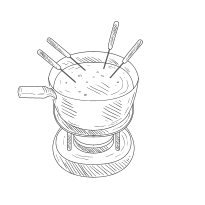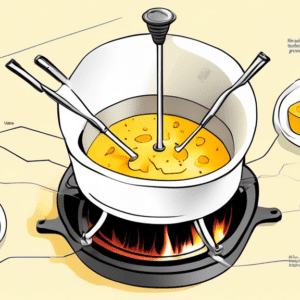How Do Fondue Pots Work: The Science Behind the Fun
From Humble Beginnings to Modern Marvels
Fondue, the convivial Swiss tradition of shared dining, has charmed its way into hearts and homes around the world. But have you ever paused, gooey fork in hand, to wonder, How does this magical pot actually work? The answer lies in a fascinating blend of simple physics and clever design, turning up the heat on both deliciousness and good company.
Dissecting the Fondue Pot: A Look Inside
Before we dive into the mechanics, let’s break down the anatomy of a fondue pot. Most pots, whether fueled by electricity or flame, consist of similar components:
- The Pot: Usually made from heat-conducting materials like ceramic, stainless steel, or cast iron, this vessel holds the star of the show—the fondue.
- The Heat Source: This is where the magic happens. Traditional fondue pots use a small burner fueled by denatured alcohol or gel fuel, while electric fondue pots have a built-in heating element.
- The Stand: Acting as a barrier between the hot pot and your tabletop, the stand provides stability and safety.
- The Forks: Long-stemmed forks, often color-coded, prevent accidental burns and make dipping a breeze.
The Science of Melting: It’s All About Heat Transfer
Regardless of the fondue pot’s design, the fundamental principle at play is heat transfer—the movement of heat energy. In this case, heat travels from the heat source to the pot and finally to the fondue itself. This transfer occurs through three primary mechanisms:
1. Conduction: Heat’s Direct Path
When you place the fondue pot over a flame or activate the electric heating element, direct contact transfers heat to the pot’s base. This method, called conduction, is highly efficient for materials like metal, which are excellent heat conductors. The heat then spreads evenly across the pot’s surface.
2. Convection: Riding the Heat Current
Convection kicks in as the fondue melts. This process involves the movement of heat through a fluid, in our case, the liquid fondue. As the fondue near the bottom heats up, it becomes less dense and rises. Cooler fondue from above then flows down to take its place, creating a continuous circulation that ensures even heating and prevents scorching.
3. Radiation: Invisible Heat Waves
While less significant than conduction and convection, radiation also plays a role, especially with open-flame fondue pots. Radiation is the transfer of heat through electromagnetic waves. The flame itself emits radiant heat, contributing to the melting process.
Fueling the Fun: Electric vs. Traditional Fondue Pots
The eternal debate—which fondue pot reigns supreme? Both electric and traditional fondue pots have their merits, depending on your needs and preferences.
Electric Fondue Pots: Modern Convenience
- Precise Temperature Control: Most electric fondue pots feature adjustable temperature settings, allowing you to fine-tune the heat for different fondue types, from creamy cheese to decadent chocolate.
- Safety First: Without an open flame, electric pots offer enhanced safety, making them ideal for households with children or pets.
- Portability: No need for fuel means you can enjoy fondue anywhere with an electrical outlet, perfect for parties and gatherings.
Traditional Fondue Pots: Embracing Tradition
- Authentic Experience: The flickering flame of a traditional fondue pot adds a touch of ambiance and evokes the rustic charm of Swiss alpine dining.
- Even Heating: The surrounding heat from the flame provides consistent warmth, reducing the risk of hot spots.
- No Strings Attached: No need for an outlet, making traditional fondue pots perfect for outdoor gatherings and camping trips.
Fondue Mastery: Tips and Tricks
Now that you understand the science behind fondue pots, here are a few tips to ensure a smooth and delicious fondue experience:
Choosing the Right Fondue Pot:
- Size Matters: Consider the number of people you’ll be serving. A larger pot is better for bigger groups.
- Material World: Choose a pot made from a durable, heat-conducting material that suits your style and needs.
- Fueling the Fun: Decide whether the convenience of electric or the charm of traditional aligns better with your preferences.
Preparing for Fondue Perfection:
- Pre-heating is Key: Whether using an electric or traditional pot, pre-heating ensures the fondue melts evenly and maintains its ideal temperature.
- Stir, Stir, Stir: Regular stirring prevents sticking and promotes even heat distribution throughout the fondue.
- Keep it Warm: Adjust the heat as needed to keep the fondue at a consistent temperature, perfect for dipping.
Beyond the Basics: Exploring the World of Fondue
Fondue is more than just a meal; it’s an experience, an invitation to connect and savor the simple pleasures of good food and even better company. From classic cheese fondue to decadent chocolate delights, the possibilities are endless.
Types of Fondue to Tantalize Your Taste Buds:
- Cheese Fondue: The quintessential Swiss fondue, perfect for dipping crusty bread, vegetables, and even apples.
- Meat Fondue: Also known as fondue bourguignonne, this style involves cooking bite-sized pieces of meat in hot oil or broth.
- Chocolate Fondue: A sweet tooth’s dream, ideal for dipping fruits, marshmallows, cake, and pretzels.
So, the next time you gather around a bubbling pot of fondue, take a moment to appreciate the clever design and simple science that brings this culinary delight to life. From heat transfer to carefully chosen materials, every element works in harmony to create a memorable dining experience. Cheers to the joy of fondue and the pleasures of shared meals!

